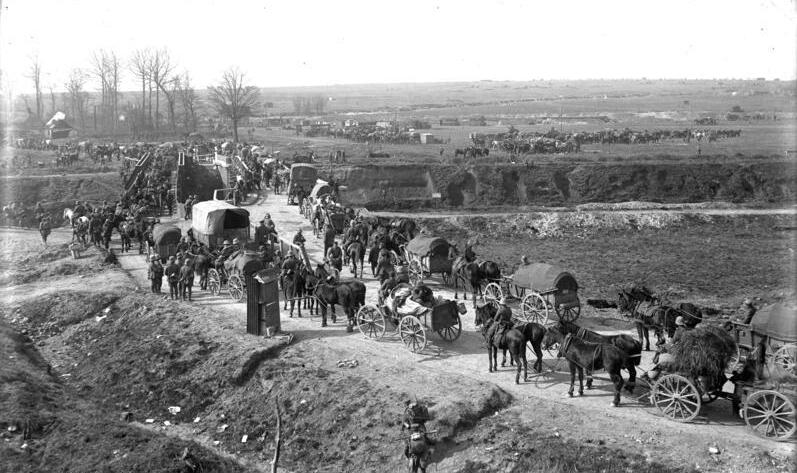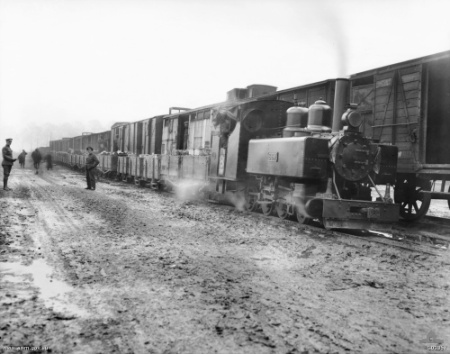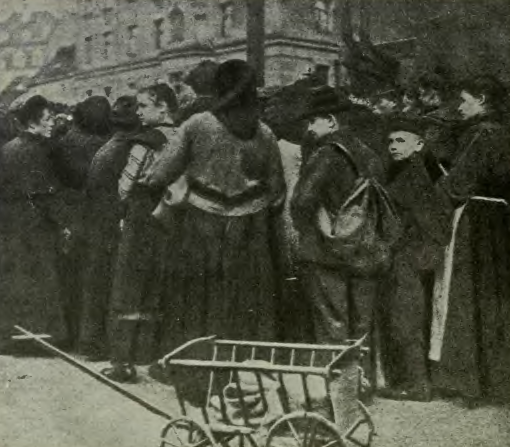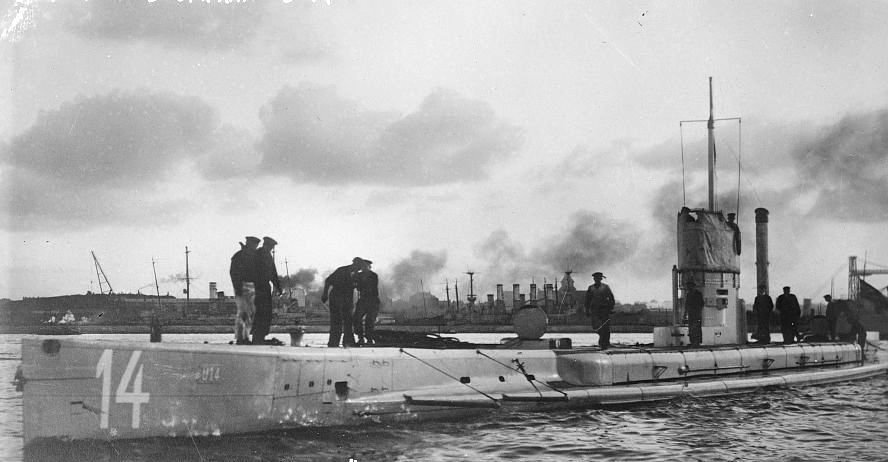|
Logistics In World War I
Logistics in World War I was the organising and delivery of supplies to the armed forces of World War I. Initial stages of the war With the expansion of military conscription and reserve systems in the decades leading up to the 20th century, the potential size of armies increased substantially, while the industrialization of firepower (bolt-action rifles with higher rate-of-fire, larger and more artillery, plus machine guns) was starting to multiply the potential amount munitions they required. Military logistical systems, however, continued to rely on 19th century technology. The main method of transportation of supplies at the start of the war was still by horse due to the lack of available alternatives in 1914, similar to that of the inclusion of cavalry within the armed forces, and the fast pace of the war in the first part of the war. When World War I started, the capabilities of rail and horse-drawn supply were stretched to their limits. As the war progressed it became ... [...More Info...] [...Related Items...] OR: [Wikipedia] [Google] [Baidu] |
World War I
World War I (28 July 1914 11 November 1918), often abbreviated as WWI, was one of the deadliest global conflicts in history. Belligerents included much of Europe, the Russian Empire, the United States, and the Ottoman Empire, with fighting occurring throughout Europe, the Middle East, Africa, the Pacific, and parts of Asia. An estimated 9 million soldiers were killed in combat, plus another 23 million wounded, while 5 million civilians died as a result of military action, hunger, and disease. Millions more died in genocides within the Ottoman Empire and in the 1918 influenza pandemic, which was exacerbated by the movement of combatants during the war. Prior to 1914, the European great powers were divided between the Triple Entente (comprising France, Russia, and Britain) and the Triple Alliance (containing Germany, Austria-Hungary, and Italy). Tensions in the Balkans came to a head on 28 June 1914, following the assassination of Archduke Franz Ferdin ... [...More Info...] [...Related Items...] OR: [Wikipedia] [Google] [Baidu] |
Trench Railways
Trench railways represented military adaptation of early 20th-century railway technology to the problem of keeping soldiers supplied during the static trench warfare phase of World War I. The large concentrations of soldiers and artillery at the front lines required delivery of enormous quantities of food, ammunition and fortification construction materials where transport facilities had been destroyed. Reconstruction of conventional roads (at that time rarely surfaced) and railways was too slow, and fixed facilities were attractive targets for enemy artillery. Trench railways linked the front with standard gauge railway facilities beyond the range of enemy artillery. Empty cars often carried litters returning wounded from the front. Overview France had developed portable Decauville railways for agricultural areas, small-scale mining and temporary construction projects. France had standardized narrow gauge Decauville military equipment and Germany adopted similar feldbahn of ... [...More Info...] [...Related Items...] OR: [Wikipedia] [Google] [Baidu] |
BBC News
BBC News is an operational business division of the British Broadcasting Corporation (BBC) responsible for the gathering and broadcasting of news and current affairs in the UK and around the world. The department is the world's largest broadcast news organisation and generates about 120 hours of radio and television output each day, as well as online news coverage. The service maintains 50 foreign news bureaus with more than 250 correspondents around the world. Deborah Turness has been the CEO of news and current affairs since September 2022. In 2019, it was reported in an Ofcom report that the BBC spent £136m on news during the period April 2018 to March 2019. BBC News' domestic, global and online news divisions are housed within the largest live newsroom in Europe, in Broadcasting House in central London. Parliamentary coverage is produced and broadcast from studios in London. Through BBC English Regions, the BBC also has regional centres across England and national news c ... [...More Info...] [...Related Items...] OR: [Wikipedia] [Google] [Baidu] |
Cambridge University Press
Cambridge University Press is the university press of the University of Cambridge. Granted letters patent by Henry VIII of England, King Henry VIII in 1534, it is the oldest university press A university press is an academic publishing house specializing in monographs and scholarly journals. Most are nonprofit organizations and an integral component of a large research university. They publish work that has been reviewed by schola ... in the world. It is also the King's Printer. Cambridge University Press is a department of the University of Cambridge and is both an academic and educational publisher. It became part of Cambridge University Press & Assessment, following a merger with Cambridge Assessment in 2021. With a global sales presence, publishing hubs, and offices in more than 40 Country, countries, it publishes over 50,000 titles by authors from over 100 countries. Its publishing includes more than 380 academic journals, monographs, reference works, school and uni ... [...More Info...] [...Related Items...] OR: [Wikipedia] [Google] [Baidu] |
Services Of Supply, American Expeditionary Forces
The Services of Supply (S. O. S.) was the support chain of the American Expeditionary Forces in France, England, Italy and the Netherlands during World War I. It was disbanded on August 31, 1919, in France. Organization The Services of Supply of the American Expeditionary Forces was established under the designation "Line of Communications," on July 5, 1917. The Line of Communications was judged by senior officers, including Colonel Johnson Hagood, who was in charge of the advance section, to be incompetent. It was re-designated "Service of the Rear" on February 16, 1918 to March 12, 1918. It was finally designated as "Services of Supply" on March 13, 1918. Its headquarters was in Tours, France. S. O. S. consisted of base sections, which provided seaport and receiving services; an intermediate section, which provided storage and services; and an advanced section, which also stored supplies and issued them to line forces. Services of Supply remained in operation until July 19, 1 ... [...More Info...] [...Related Items...] OR: [Wikipedia] [Google] [Baidu] |
First World War Glass–rubber Exchange
An exchange of rubber for optical glass was proposed by Britain and Germany during the First World War. Optical glass was vital to the warfare of this era for binoculars and gunsights and rubber was needed for tyres and communications cables. Britain had sourced the majority of its pre-war optical glass from the German company of Carl Zeiss AG and by early 1915 was suffering from a shortage. Germany, with its sea trade blockaded by allied forces, was unable to import natural rubber and found it could not create enough high-quality synthetic rubber to replace it. The British Minister of Munitions, Ministry of Munitions proposed an exchange of British-sourced rubber for German optical instruments through intermediaries in Switzerland. Terms were agreed for tens of thousands of pairs of binoculars to be exchanged but sources differ on whether any actual trade took place. By early 1916, British investment and technological improvements had increased production of optical glass su ... [...More Info...] [...Related Items...] OR: [Wikipedia] [Google] [Baidu] |
Blockade Of Germany
The Blockade of Germany, or the Blockade of Europe, occurred from 1914 to 1919. The prolonged naval blockade was conducted by the Allies of World War I, Allies during and after World War I in an effort to restrict the maritime supply of goods to the Central Powers, which included German Empire, Germany, Austria-Hungary and the Ottoman Empire. The blockade is considered one of the key elements in the eventual Allied victory in the war. The German Board of Public Health in December 1918 claimed that 763,000 German civilians had already died from starvation and disease, caused by the blockade.C. Paul Vincent, ''The Politics of Hunger: the Allied Blockade of Germany, 1915–1919''. Athens, Ohio: Ohio University Press, 1985. p. 141 An academic study done in 1928 put the death toll at 424,000. An additional 100,000 people may have died during the post-armistice continuation of the blockade in 1919. Both Germany and the United Kingdom relied heavily on imports to feed their population ... [...More Info...] [...Related Items...] OR: [Wikipedia] [Google] [Baidu] |
Military Logistics
Military logistics is the discipline of planning and carrying out the movement, supply, and maintenance of military forces. In its most comprehensive sense, it is those aspects or military operations that deal with: * Design, development, acquisition, storage, distribution, maintenance, evacuation, and disposition of materiel. * Transport of personnel. * Acquisition or construction, maintenance, operation and disposition of facilities. * Acquisition or furnishing of services. * Medical and health service support. Etymology and definition The word "logistics" is derived from the Greek adjective ''logistikos'' meaning "skilled in calculating", and the corresponding Latin word ''logisticus''. In turn this comes from the Greek ''logos'', which refers to the principles of thought and action. Another Latin root, ''log-'', gave rise to ''logio'', meaning to lodge or dwell, around 1380, and became the French verb , meaning "to lodge". Around 1670, the French King Louis XIV created t ... [...More Info...] [...Related Items...] OR: [Wikipedia] [Google] [Baidu] |
U-boat
U-boats were naval submarines operated by Germany, particularly in the First and Second World Wars. Although at times they were efficient fleet weapons against enemy naval warships, they were most effectively used in an economic warfare role (commerce raiding) and enforcing a naval blockade against enemy shipping. The primary targets of the U-boat campaigns in both wars were the merchant convoys bringing supplies from Canada and other parts of the British Empire, and from the United States, to the United Kingdom and (during the Second World War) to the Soviet Union and the Allied territories in the Mediterranean. German submarines also destroyed Brazilian merchant ships during World War II, causing Brazil to declare war on both Germany and Italy on 22 August 1942. The term is an anglicised version of the German word ''U-Boot'' , a shortening of ''Unterseeboot'' ('under-sea-boat'), though the German term refers to any submarine. Austro-Hungarian Navy submarines were also kno ... [...More Info...] [...Related Items...] OR: [Wikipedia] [Google] [Baidu] |
Naval Superiority
Command of the sea (also called control of the sea or sea control) is a naval military concept regarding the strength of a particular navy to a specific naval area it controls. A navy has command of the sea when it is so strong that its rivals cannot attack it directly. This dominance may apply to its surrounding waters (i.e., the littoral) or may extend far into the oceans, meaning the country has a blue-water navy. It is the naval equivalent of air supremacy. With command of the sea, a country (or alliance) can ensure that its own military and merchant ships can move around at will, while its rivals are forced either to stay in port or to try to evade it. It also enables free use of amphibious operations that can expand ground-based strategic options. The British Royal Navy held command of the sea for most of the period between the 18th to the early 20th centuries, allowing Britain and its allies to trade and to move troops and supplies easily in wartime, while its enemies ... [...More Info...] [...Related Items...] OR: [Wikipedia] [Google] [Baidu] |
Unrestricted Submarine Warfare
Unrestricted submarine warfare is a type of naval warfare in which submarines sink merchant ships such as freighters and tankers without warning, as opposed to attacks per prize rules (also known as "cruiser rules") that call for warships to search merchantmen and place crews in "a place of safety" (for which lifeboats do not qualify, except under particular circumstances) before sinking them, unless the ship shows "persistent refusal to stop ... or active resistance to visit or search". To follow the rules a submarine must surface, defeating the purpose of submarines and putting itself in danger of attack. History Limitations on warfare at sea date back to the 1899 Hague Convention. During the First World War, the United Kingdom introduced Q-ships with concealed deck guns and many armed merchantmen, leading Germany to ignore the prize rules. In the most dramatic episode they sank in 1915 in a few minutes because she was carrying war munitions. The U.S. demanded it stop, and ... [...More Info...] [...Related Items...] OR: [Wikipedia] [Google] [Baidu] |
United States Of America
The United States of America (U.S.A. or USA), commonly known as the United States (U.S. or US) or America, is a country primarily located in North America. It consists of 50 states, a federal district, five major unincorporated territories, nine Minor Outlying Islands, and 326 Indian reservations. The United States is also in free association with three Pacific Island sovereign states: the Federated States of Micronesia, the Marshall Islands, and the Republic of Palau. It is the world's third-largest country by both land and total area. It shares land borders with Canada to its north and with Mexico to its south and has maritime borders with the Bahamas, Cuba, Russia, and other nations. With a population of over 333 million, it is the most populous country in the Americas and the third most populous in the world. The national capital of the United States is Washington, D.C. and its most populous city and principal financial center is New York City. Paleo ... [...More Info...] [...Related Items...] OR: [Wikipedia] [Google] [Baidu] |








